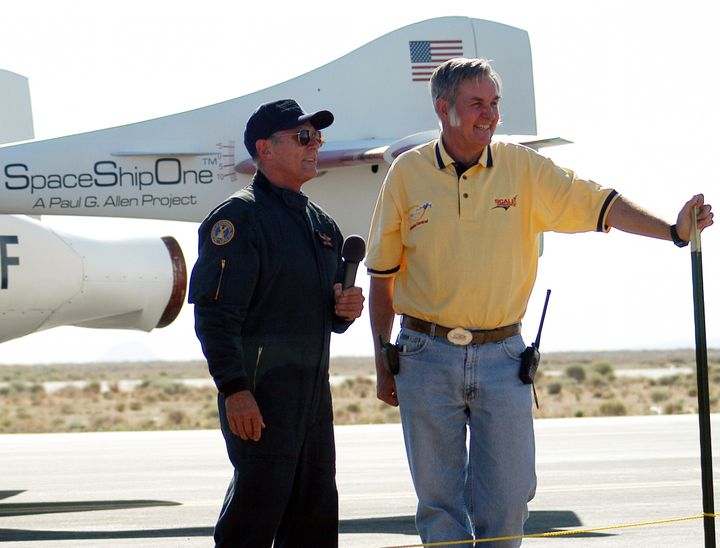
It's been a long-standing dream of humanity to go into space. But for decades, it was only possible to do it with a government entity. You had to join NASA or be a Soviet Union citizen, and ideally a male test pilot with military experience. Even after the space shuttle opened up entries to more scientists, women and people of other backgrounds, spaceflight remained the purview of a select few.
Meanwhile, computers were shrinking and materials for space becoming more lightweight. Theoretically, this made rocketing above Earth more affordable than it would have been in the 1960s or 1970s. Could it be possible to have a company bring people into space? HeroX co-founder Peter Diamandis and others at the XPRIZE Foundation believed it was possible. They launched a competition (later called the Ansari XPRIZE) that would award $10 million to the first company to bring a piloted spacecraft into space twice and back, safely.
"Much like the Orteig Prize competition that launched today’s $300 billion commercial aviation industry, the winning technology from the $10M Ansari XPRIZE was licensed by Richard Branson to create Virgin Galactic, and a new era of commercially viable space travel is born," the Ansari XPRIZE website read.
Yes, that was the result -- in 2004, Scaled Composites' SpaceShipOne safely made it into space twice and secured the prize. Just before the winning flight on Oct. 4, 2004, Virgin founder Richard Branson announced that he would partner with Scaled Composites to start a brand-new space tourism company, called Virgin Galactic. Money for the prize came courtesy of Amir, Hamid and Anousheh Ansari; today, Anousheh is also remembered as the first female private space explorer, who spent time aboard the International Space Station.
But it took eight years, 26 teams and a lot of hard work to get to that fateful pair of flights in 2004. Entries poured in from seven countries. While SpaceShipOne was the only one to make it to suborbital space, multiple teams made tests. The da Vinci Project reportedly planned their first flight for Oct. 2, 2004, but the pieces they needed arrived too late. Space Transport Corp. also did two unpiloted test launches that ended in disaster. Other entities announced intentions for flight, but ultimately did not follow through.
Diamandis famously referred to the XPRIZE as a sort of "space barnstorming", hailing back to the days when maverick pilots would go from town to town doing a few tricks to earn money in local competitions. In this case, however, the stakes were higher and far more professional. It takes a precise combination of engineering, timing and funding to send people aloft safely. To gain the respect of government, all three would be necessary.
A few things helped the SpaceShipOne team stand out. There were deep pockets involved for development from Paul Allen, a co-founder of Microsoft with many millions to spare. The design was done by Burt Rutan, who was known in the industry for his aerospace work. And the pilots themselves, Mike Melvill and Brian Binnie, had many years of aviation experience behind them. Binnie, who piloted the winning flight, joked to NBC that his flight "wasn't as much fun as Mike's, but we got a bit higher."
To get into space, SpaceShipOne rode underneath a carrier aircraft called WhiteKnightOne. Once the pair got to about 47,000 feet, SpaceShipOne was released and rocketed up to 367,442 feet (69.6 miles), well above the 62.5-mile minimum specified by prize organizers. "It is a thrill that I think everybody should have once in a lifetime," Binnie added to NBC.
The feat attracted quite a bit of attention. Then-president George W. Bush called to congratulate the winners. Erik Lindbergh, the grandson of famed aviator Charles Lindbergh and a part of the XPRIZE board, reportedly offered excitement and support after the competition was won. And Branson promised that the first flights with a successor spacecraft would take place in about three years. Of course, we are still awaiting that kind of spaceflight to occur.
So where is private spaceflight today? It hasn't moved as fast as some would have hoped. In fact, Virgin Galactic suffered a devastating fatal crash last year when successor SpaceShipTwo crashed during a test flight. Back then, the company expressed hopes that it would run the first commercial private spaceflight this year. But with the crash, an investigation is ongoing and it's unclear when people will actually climb aboard one of the spacecraft again.
Meanwhile, another company called XCOR Aerospace is offering rides using a spacecraft dubbed Lynx. A prototype is under construction and may take to the air later this year, but it is unknown if that will happen as planned. However, there are ticket-buyers patiently lined up for both of these companies, providing a potential source of revenue once flights get going.
SpaceShipOne represented a beginning, a hope that private spaceflight would take off. Perhaps it may take a few extra years to get there, but exploration is like that. Recall that we went to the moon in the 1960s and 1970s, and even today we haven't yet turned things around to bring people back there. Patience, hope and hard work will be necessary on the part of the companies planning to bring people above Earth. But the achievement still stands as a monument to what is possible if the dominoes line up correctly.
Top image: Mike Melvill (left) and Burt Rutan speak to the media following a SpaceShipOne flight. Credit: Wikimedia Commons/D Ramey Logan








